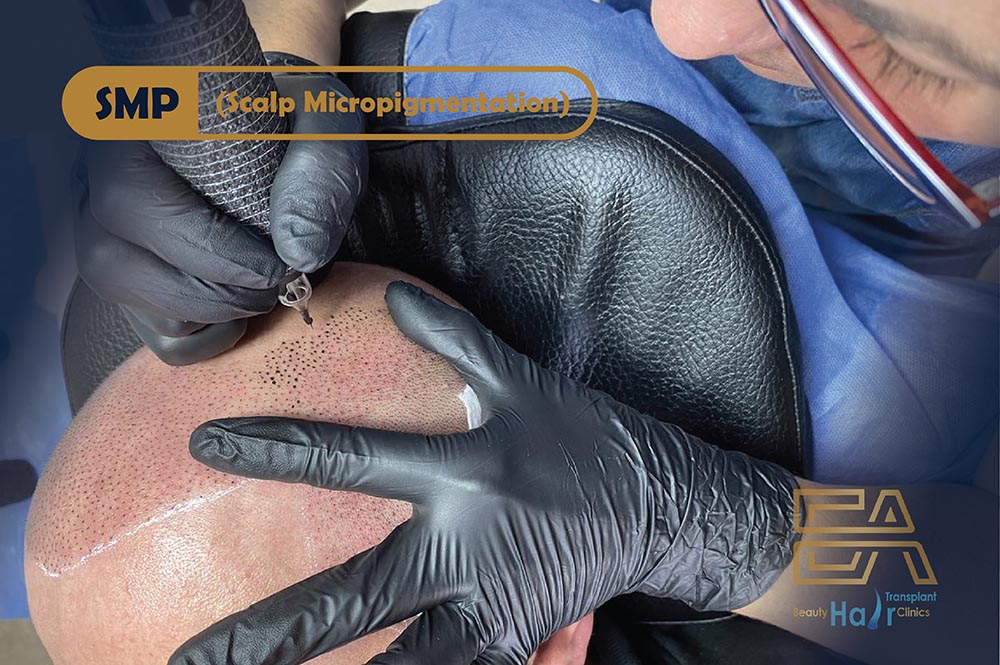SMP Scalp Micropigmentation
SMP Scalp Micropigmentation
Even though our office specializes in using hair restoration surgery to address hair loss, we are aware that it is not the only “tool” in the “tool chest.” Although it may not be the best option for all people and may be even more effective when used in combination with other treatments, we personally think it is the most effective treatment for hair loss. Scalp Micropigmentation, or SMP, is one of these additional therapies. It is a minimally invasive, non-surgical method that can conceal scars while also making long hair appear thicker and resembling short “stubble” for a shaved-head appearance. But who does SMP serve? How does the procedure work? If so, how should it be used in conjunction with a hair transplant? if so, how long after a hair transplant should you wait before undergoing SMP?
What is SMP?
SMP is a tattooing-like process where a device, much like a tattoo gun, is used to put pigment into the skin. While it
SMP differs significantly from a tattoo in numerous significant aspects. The scalp is the only part of the body to which SMP is applied. Additionally, SMP is only applied as tiny “dots” that resemble hair follicles that have been shaved off or hair “stubble.” These dots resemble thick, dense, but shaven hair when they are clustered closely together. Second, the SMP procedure uses a specific pigment rather than regular tattoo ink. Metal pigments found in tattoo ink have a tendency to oxidize and change color over time (blacks take on a green or blue tint). However, SMP pigment ink won’t change color. Thirdly, in contrast to a typical tattoo, which embeds the ink deeper into the tissue, SMP pigment is only placed into the most superficial layer of the skin. Lastly, most SMP is designed to only last temporarily and naturally fade — typically within 24 months. There is usually no abnormal appearance when it fades and can be touched-up if the patient still wants the SMP “look.”
SMP differs significantly from a tattoo in numerous significant aspects. The scalp is the only part of the body to which SMP is applied. Additionally, SMP is only applied as tiny “dots” that resemble hair follicles that have been shaved off or hair “stubble.” These dots resemble thick, dense, but shaven hair when they are clustered closely together. Second, the SMP procedure uses a specific pigment rather than regular tattoo ink. Metal pigments found in tattoo ink have a tendency to oxidize and change color over time (blacks take on a green or blue tint). However, SMP pigment ink won’t change color. Thirdly, in contrast to a typical tattoo, which embeds the ink deeper into the tissue,
Before Forehead Lifting
SMP is really for any patient looking to improve the appearance of their scalp. However, there are typically three types of patients seeking SMP:
- Hair loss patients who shave their heads to mimic the look of a full head of “stubble.” This gives the appearance of a full head of hair that has been cut very short and enables proper framing of the face with a fresh hairline.
- People with long, thin hair who desire to make their hair appear denser. The colour disparity between the skin and hair shaft is lessened and the scalp is less noticeable by using SMP on the scalp and darkening the skin tone. This gives the area a thicker appearance overall. Patients who have had hair transplant surgery in the past are included.
- People who have scars on their scalp. These include scars from previous, non-surgical trauma as well as FUT (“strip”) and FUE scars.
Should SMP be Used With a Hair Transplant?
SMP is frequently a beneficial addition to hair transplant surgery. Is it required for good cosmetic results? Without a doubt. SMP and hair transplantation can both function on their own and produce effective outcomes. However, many patients believe that combining the two is beneficial. This includes patients who have FUE to achieve a shorter “buzz cut” look and then use SMP to thicken the appearance overall, patients who wear their hair longer and want to thicken the entire appearance or specific regions (typically the crown), and patients who have had prior FUE or FUT scarring who want to conceal these further to wear their hair even shorter in the donor area.
How Long after Hair Transplant Surgery Before I can have SMP?
The majority of SMP experts advise delaying SMP for six months after hair transplant surgery. The purpose of doing this is to give the inflammation and skin-tone alterations time to entirely subside, as both of these phenomena can influence how the tissue takes the pigmentation. Before using SMP, the SMP experts prefer that the skin be essentially restored to “normal” (albeit this truly does take a full 12–18 months).



